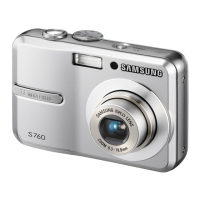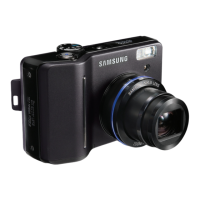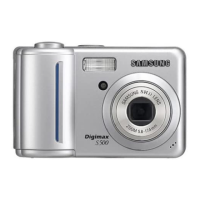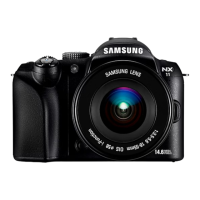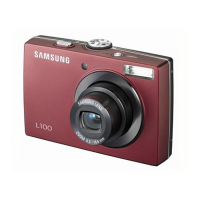Do you have a question about the Samsung SL202 - Digital Camera - Compact and is the answer not in the manual?
Install the software to move photos to the computer and edit them.
Take a photograph.
Connect the camera to the computer using the USB cable.
Turn on the camera if it is off.
Open Windows Explorer and find the removable disk.
List of items included with the camera.
List of optional accessories.
Diagram identifying front and top camera components.
Diagram identifying rear camera components.
Diagram identifying bottom camera components.
Description of self-timer lamp states and meanings.
Explanation of various shooting mode icons.
Description of camera status lamp states and meanings.
Details about the camera's rechargeable battery.
Battery life estimates for still images and movies.
Guidelines for connecting the camera via USB.
Step-by-step instructions for charging the battery.
Explanation of the AC adapter's charge indicator lights.
Instructions for correctly inserting the battery.
Explanation of battery level indicators.
Instructions for correctly inserting the memory card.
Information on compatible memory card types.
Explanation of the memory card's write-protect switch.
Table showing approximate shooting capacity for 1GB SD card.
Importance of fully charging the battery before initial use.
Initial setup menu for date, time, and language.
Steps to select the desired language for the camera.
Instructions for setting the date, time, and date format.
Icon and page for playback mode.
Icons and page for zoom settings.
Icon and page for voice memo function.
Icon and page for remaining shots indicator.
Icons for memory card and internal memory status.
Icon and page for battery status.
Icon and page for flash status.
Icon and page for self-timer.
Icon and page for macro mode.
Icon and page for style selection.
Icons and pages for face/smile/blink detection.
Icon and page for face tone adjustment.
Icons and pages for retouch/photo adjust/silent.
Display format for date and time.
Icon for camera shake warning.
Indicator for autofocus frame.
Icon and page for drive mode.
Icons and pages for metering and slow speed.
Icons and pages for image quality and frame rate.
Icon and page for image size.
Icon and page for ISO setting.
Icon and page for white balance.
Icon and page for exposure compensation.
How to select shooting modes using the mode dial.
Guide to rotating the mode dial for shooting mode selection.
Instructions for taking quick and easy photos in Auto mode.
Using Program mode for optimal settings and manual control.
Using Digital Image Stabilization for clearer photos in low light.
Guide to correct filming methods and problem-solving.
List of functions available in the movie guide mode.
Portrait mode for retouching facial imperfections.
Using scene modes for optimal settings in various shooting situations.
Using Frame Guide to have someone else take a photo.
Setting shutter speed and aperture for night mode.
Recording moving images with or without sound.
Instructions for recording silent movies.
Pausing and resuming movie recording.
Camera automatically selects settings based on detected scene type.
Conditions for scene recognition in Smart Auto mode.
How to turn the camera on and off.
Using the shutter button for taking photos and recording.
How to use focus lock for subjects not in the center.
Choosing the appropriate flash mode.
Table showing flash range for different ISO and modes.
Explanation of flash mode icons and their descriptions.
Table of flash modes available in different shooting modes.
Cancelling self-timer function.
Recommendation to use a tripod.
Self-timer limitation in movie mode.
How to select self-timer modes (10 sec, 2 sec, double, motion detection).
Description of self-timer indicator icons.
Motion detector operation and conditions.
Conditions where motion detector may not function.
Exposure value adjustment.
Adjusting colors based on light source.
Adjusting image sensitivity for different lighting conditions.
Function for detecting and adjusting faces.
Adjusting face tone for beauty shots.
Retouching face for clearer skin.
Setting image and movie file sizes.
Automatic contrast adjustment.
Setting image quality and frame rate.
Adjusting exposure metering.
Adjusting shooting type.
Adjusting autofocus area.
Applying photo styles.
Adjusting contrast, sharpness, saturation.
Voice recording settings.
Setting slow shutter speeds.
Using the OK button to navigate and confirm menu options.
Accessing and enabling functions via the MENU button.
Adjusting exposure value for optimal brightness.
Adjusting colors for natural appearance under different lighting.
Setting custom white balance using a white paper.
Adjusting image sensitivity for different lighting conditions.
Camera's ability to detect and focus on human faces.
Auto face detection for quick portrait shots.
Face detection capability and limitations.
Facilitating self-portraits by automatically detecting the face.
Adjusting skin tone for beauty shots.
Improving skin appearance for portraits.
Automatic photo taking when a smile is detected.
Capturing photos automatically when eyes are closed.
Selecting the appropriate image size.
Choosing compression rate and frame rate.
Automatic contrast adjustment for backlit scenes.
Changing exposure metering methods.
Selecting continuous shooting, AEB, and movie recording.
Selecting autofocus area based on shooting conditions.
Applying various effects to images.
Adjusting contrast, sharpness, and saturation.
Changing image contrast.
Adjusting image sharpness.
Changing image saturation.
Adding noise effect for a classic look.
Adding voice memos to still images.
Recording voice clips up to 10 hours.
Pausing and resuming voice recording.
Recording movies without audio.
Adjusting sound volume for startup, shutter, and AF.
Selecting the startup sound each time the camera turns on.
Selecting the shutter sound.
Enabling camera sound alerts for button presses.
Enabling AF sound for operational status confirmation.
Setting self-timer for self-portraits.
Display settings for the camera.
Selecting the display language for the LCD monitor.
Showing or hiding function descriptions on the screen.
Selecting the image displayed when the camera turns on.
Adjusting the LCD brightness.
Viewing captured images briefly on the LCD.
Enabling the LCD screen saver.
Erasing all images and formatting the memory card.
When to format memory cards.
Restoring all camera settings to default.
Changing date, time, and time zone settings.
Setting the local time zone for travel.
Setting the file naming convention.
Option to imprint date/time on still images.
Setting the camera's auto power-off timer.
Choosing between NTSC and PAL video output.
Displaying image and menus on an external monitor.
Enabling or disabling the autofocus assist lamp.
Configuring USB connection mode for PC or printer.
Viewing still images stored in memory.
Playing back recorded movies.
Disabling sounds during playback.
Capturing still frames from movie playback.
Playing back recorded voice files.
Playing back voice memos attached to still images.
Indicator for playback mode.
Indicator for voice memo.
Indicator for DPOF (Digital Print Order Format).
Indicator for protected images.
Display of current folder and file name.
Indicator showing if a memory card is inserted.
Indicator for battery status.
Indicator for ISO setting.
Indicator for aperture value.
Indicator for shutter speed.
Indicator for flash status (On/Off).
Indicator for image size.
Indicator for recording date.
Viewing thumbnails and zooming images.
Viewing and organizing images by category.
Finding and deleting image files.
Filtering images by date, color, etc.
Enlarging and viewing parts of an image.
Cropping and saving selected parts of an image.
Deleting images from the memory card.
Selecting multiple images for deletion.
Adjusting slideshow effect, interval, and music.
Selecting slideshow effects.
Setting the slideshow interval.
Selecting background music for slideshows.
Managing image files like deleting and protecting.
Deleting files.
Protecting files from deletion.
Adding voice memos to photos.
Setting print order format for DPOF.
Copying files.
Editing captured images.
Changing image resolution.
Rotating images.
Applying photo styles.
Adjusting photo settings like brightness and contrast.
Viewing images in different display modes.
Starting slideshows.
Starting slideshow playback.
Playback modes for slideshows.
Selecting images for playback.
Selecting images for printing.
Setting paper size for printing.
Setting print layout on paper.
Configuring paper type for printing.
Setting print quality.
Configuring date printing.
Configuring file name printing.
Resetting printer settings to default.
Resizing photos.
Table of image size options and zoom factors.
Rotating images by 90 or 180 degrees.
Applying various styles to images.
Adjusting R, G, B values for custom color effects.
Automatic brightness adjustment for dark areas.
Removing red-eye effect from captured images.
Improving skin appearance for portraits.
Adjusting image brightness.
Adjusting image contrast.
Adjusting image saturation.
Adding noise effect for a classic look.
Viewing and organizing images, videos, and audio files.
Initiating slideshow playback from the menu.
Navigating to the slideshow start option.
Choosing slideshow playback modes.
Slideshow closes after one cycle.
Slideshow repeats until cancelled.
Starting the slideshow playback.
Selecting images to display in the slideshow.
Applying special screen effects to the slideshow.
Setting the playback interval for slideshows.
Adding background music to slideshows.
Deleting images from the memory card.
Selecting images to delete.
Deleting all unprotected images.
Locking or unlocking images to prevent accidental deletion.
Selecting individual images for protection.
Protecting or unprotecting all images at once.
Adding voice memos to photos.
Setting print order format for digital printing.
Setting print quantity for images.
Selecting images for printing.
Setting print quantity for all images.
Printing index sheets of images.
Specifying print size for images.
Selecting images and print size.
Changing print size for all images.
Copying images, videos, and voice files to the memory card.
Copying all internal memory files to the memory card.
Cancelling the copy operation.
Printing images directly from the camera to a PictBridge printer.
Steps to connect the camera and printer.
Setting the camera for printer connection via USB.
Selecting the number of copies for printing.
Setting paper size for printing.
Setting print layout.
Configuring paper type.
Setting print quality.
Configuring date printing.
Configuring file name printing.
Resetting PictBridge settings to default.
Memory card error and solutions.
Memory card is locked, and how to unlock it.
Memory card or internal memory is full.
No images stored on the memory card.
File error and solutions.
Battery is discharged, insert new batteries.
Details about the camera's image sensor.
Specifications of the camera lens.
Type of image stabilization.
LCD monitor specifications.
Autofocus type and range.
Focusing range for different modes.
Shutter speed ranges for different modes.
Exposure control, metering, and compensation.
Flash modes, range, and recycle time.
Sharpness settings.
White balance modes.
Voice recording specifications.
Date imprint options.
Shooting modes and scene modes.
Internal and external memory specifications.
Supported file formats for images and video.
Image size options for still and movie modes.
Available image effects.
Playback modes and features.
Connectivity options (USB, Audio, Video).
Battery and charger specifications.
Camera dimensions.
Camera weight.
Recommended operating temperature range.
Recommended operating humidity range.
Included software.
Initial step to install camera software for PC connection.
Link to Samsung's website for software.
Autoplay dialog for software installation.
Installing DirectX and Samsung Master software.
Connecting the camera after software installation.
Powering on the camera after connection.
Availability of PDF manuals on the software CD.
Prerequisites for installing Acrobat Reader.
How the camera enters PC connection mode.
Downloading images to PC in computer connection mode.
Adjusting camera settings for PC connection.
Steps for connecting the camera to a PC.
Downloading still images to PC for editing or printing.
Connecting camera to PC via USB.
Accessing camera files on PC.
Viewing image files on the computer.
Selecting an image for operations.
Procedure for safely disconnecting the camera from PC.
Accessing context menu for file operations.
Choosing between cut or copy file operations.
Cutting a selected file.
Copying files.
Selecting destination folder for pasting files.
Pasting files into the selected folder.
Transferring image files from camera to PC.
Illustrations may differ based on Windows version.
Accessing the Safely Remove Hardware utility.
Stopping the USB mass storage device.
Confirming device stop.
Safely removing the hardware.
Closing the hardware removal window.
Disconnecting the USB cable.
Samsung Master's image viewer features.
Samsung Master's image editor features.
Editing capabilities for movie clips.
Editing capabilities for movie clips.
List of movie editing functions.
Options within the Edit menu.
Adding multimedia files to moving images.
Adjusting brightness, contrast, color, or saturation.
Inserting effects into clips.
Inserting text into clips.
Adding narration to clips.
Saving edited multimedia files.
Window for inserting multimedia into frames.
MAC OS support for camera drivers.
Verifying MAC OS version compatibility.
MAC OS compatibility information.
Connecting camera to MAC and enabling PC mode.
New desktop icon after MAC connection.
Accessing memory folder on MAC.
Copying or moving photo files to MAC.
Troubleshooting USB cable connection issues.
Troubleshooting camera recognition by PC.
Troubleshooting file transfer errors.
Troubleshooting issues with USB hubs.
Troubleshooting conflicts with other USB devices.
Troubleshooting unrecognized devices in Device Manager.
Troubleshooting security software interference with camera recognition.
Troubleshooting front USB port connection issues.
Installing DirectX for software compatibility.
Troubleshooting camera connection freezes during Windows startup.
Troubleshooting file transfer and disk ejection errors.
| Brand | Samsung |
|---|---|
| Model | SL202 - Digital Camera - Compact |
| Category | Digital Camera |
| Language | English |





